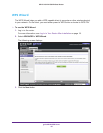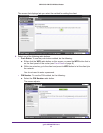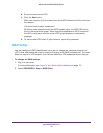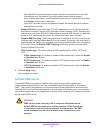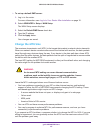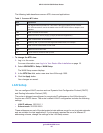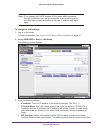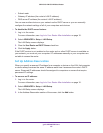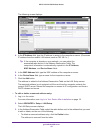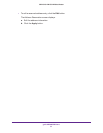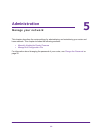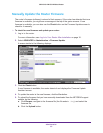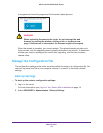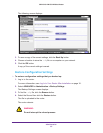
genie ADVANCED Home
48
JNR1010v2 N150 Wireless Router
receives RIP packets. Both is the default setting. With the Both or Out Only setting,
the router broadcasts its routing table periodically. With the Both or In Only setting,
the router incorporates the RIP information that it receives.
• RIP Version. This setting controls the format and the broadcasting method of the RIP
packets that the router sends. It recognizes both formats when receiving. By default,
the RIP function is disabled. Three RIP versions exist:
- RIP-1 is universally supported. It is adequate for most networks, unless you have
an unusual network setup.
- RIP-2B uses subnet broadcasting.
- RIP-2M uses multicasting.
4. To set your computers’ IP addresses manually, clear the Use Router as DHCP Server check
box.
NETGEAR recommends that you do not do this. For more information, see Use Router as
DHCP Server on page 48.
5. To reserve an IP address for a computer or device on the LAN, in the Address Reservation
section, click the Add button.
For more information, see Set Up Address Reservation on page 49.
6. Click the Apply button.
Your changes are saved.
Use Router as DHCP Server
By default, the router functions as a DHCP server, enabling it to assign IP, DNS server, and
default gateway addresses to all computers and devices that are connected to the router’s
LAN. The assigned default gateway address is the LAN address of the router. The router
assigns IP addresses to the attached computers and devices from a pool of addresses
specified on the LAN Setup screen. Each pool address is tested before it is assigned to avoid
duplicate addresses on the LAN. For most applications, the default DHCP and TCP/IP
settings of the router function well.
You can specify the pool of IP addresses that are assigned by setting the starting IP address
and ending IP address. These addresses should be part of the same IP address subnet as
the router’s LAN IP address. Using the default addressing scheme, the default range is
192.168.1.2–192.168.1.254, although you might want to save part of this range for devices
with fixed addresses.
• Starting IP Address. Specify the start of the range for the pool of IP addresses in the
same subnet as the router. The IP address 192.168.1.2 is the default starting address.
• Ending IP Address. Specify the end of the range for the pool of IP addresses in the
same subnet as the router. The default ending IP address is 192.168.1.254.
The router delivers the following parameters to any LAN device that requests DHCP
information:
• An IP address from the range that you have defined



